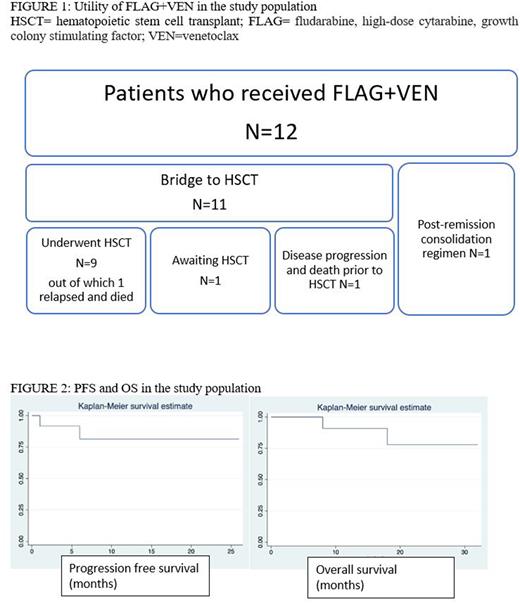Abstract
Background
About 40% of patients with newly diagnosed acute myeloid leukemia (ND-AML) relapse. While 10-40% of younger AML patients are primarily refractory to induction therapy, the proportion is significantly higher for patients aged ≥ 60 years (40-60%). Measurable residual disease (MRD) negativity prior to hematopoietic stem cell transplant (HSCT) is associated with significantly greater overall survival (OS) and reduced relapse rates. Median time to relapse post-HSCT is approximately 4 months, with majority of relapses occurring within 2 years. One-year survival post-HSCT was 94% in ND-AML and 78% in relapsed/refractory AML. Identifying consolidation regimens that help achieve deeper remission will translate into improved OS. Further, there is no established consensus on post-remission bridging-chemotherapy regimens while awaiting HSCT. This study aimed to assess the utility of fludarabine, high-dose cytarabine, growth colony stimulating factor with venetoclax (FLAG+VEN) as a consolidation regimen, or bridge to HSCT in eligible patients.
Methods
We performed a retrospective chart review to identify all patients age ≥18 years who were diagnosed with AML and received at least one cycle of Fludarabine 30mg/m2 IV D2-6, cytarabine 1.5gm/m2 IV D2-6, filgrastim 5mcg/kg SC D1-7, venetoclax 400mg po D 1-14 at Tulane Medical Center, New Orleans. We collected patient demographics, disease and treatment characteristics, responses, and outcomes. Descriptive analysis was used to summarize the characteristics and outcomes of our data set.
Results
FLAG+VEN was used as a consolidation treatment or bridge to transplant in 12 patients. Seventy-five percent (N = 9) were induced with 7 + 3 and 25% (N=3) received CPX-351. Of these, Seventy-five percent (N=9) were Caucasian, 25% (N=3) African American. European Leukemia Network risk classification stratified 50% (N=6) as poor-risk, 41.6% (N=5) as intermediate-risk and 8.3% (N=1) as favorable-risk. Seventy-five percent (N=9/12) were able to successfully transition to HSCT and all of them engrafted with >95% T cell donor-chimerism at 30 days post-transplant. Eight-point-three % (N=1/12) are awaiting HSCT, 8.3% (N=1/12) refused transplant and 8.3% (N=1/12) had disease progression. MRD status post FLAG+VEN and prior to HSCT was done in 7 out of 12 patients and all of them were negative. Among the two patients who were not transplanted, one received 3 cycles of FLAG+VEN as consolidation and he remains in remission after 1 year of last consolidation chemotherapy. Intention of FLAG+VEN use is depicted in Figure 1. Median PFS and Median OS was not reached for this cohort as seen in Figure 2. Overall survival at 6-month, 12-month and 18-month was 100%, 90.9% and 75% respectively excluding those who did not meet the defined follow-up period. Neutropenic fever post FLAG+VEN was seen in 25% (N=3) of the patients (sources: viridians streptococcal bacteremia and invasive fungal infection in N=1; unidentified source in N=2). There were 2 deaths, with cause of death being intracranial hemorrhage and relapsed AML post allo transplant.
Conclusions:
To our knowledge there is no documented literature about using FLAG+VEN as a consolidation/bridge chemotherapy to HSCT in AML. Our experience highlights the successful use of FLAG+VEN in achieving deeper and durable remissions. This regimen allowed majority of eligible patients to transition to HSCT with >95% T cell donor-chimerism at 30 days post-transplant, thereby foregrounding its role as bridge to allogeneic HSCT and other maintenance therapies. It was well tolerated in most patients. Limitations of our study include the small sample size, retrospective nature of data collection and lack of MRD data on all patients. Further research in the use of FLAG+VEN as a consolidation/bridge to HSCT is warranted, with need for prospective and randomized clinical trials.
Disclosures
Safah:Incyte: Speakers Bureau; Blueprint: Speakers Bureau; Janssen: Speakers Bureau; Astellas: Speakers Bureau. Saba:ADC Therapeutics: Other: Advisory Board; Pharmacyclics: Other: Advisory Board, Speakers Bureau; AbbVie: Consultancy, Other: Advisory Board, Speakers Bureau; Janssen: Other: Advisory Board, Speakers Bureau; Kyowa Kirin: Other: Advisory Board.
Author notes
Asterisk with author names denotes non-ASH members.


This feature is available to Subscribers Only
Sign In or Create an Account Close Modal